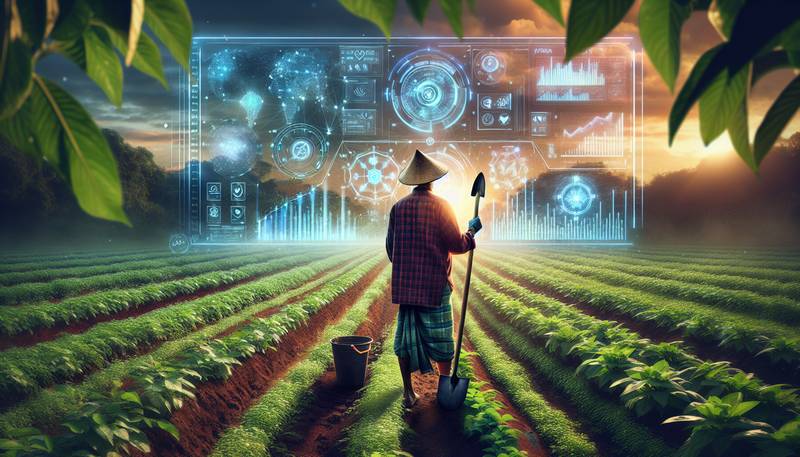Agritech's Role in Achieving Net Negative Emissions: Innovations in Sustainable Agriculture

The Green Revolution 2.0: Love at First BytePicture this: a farmer, gloves on and shovel in hand, staring intently at a computer screen displaying an array of data that even NASA would be envious of. Welcome to the era where agritech unites the age-old romance of farming with the digital prowess of Silicon Valley. The goal? Sustainable agriculture that not only feeds the planet but also helps plants breathe easier—literally! It’s all about turning the farming industry into a carbon-negative powerplant, one potato at a time.From Soybeans to Software: Meet the Tech-savvy FarmersTraditional farming methods might evoke images of grandpa wearing overalls and wielding a pitchfork, but the modern farmer is more likely to be spotted with a smartphone, a drone, and what can only be described as a PhD in data analytics. With advancements in precision agriculture, farmers can monitor soil health, optimize irrigation schedules, and even have a chat with their crops—ok, maybe not a chat, but you get the point!The reason this shift matters is simple: by using technology, farmers can reduce emissions and increase yields. Here’s how they do it:- Soil Sensors: Because who needs to guess when you can know? Sensors tell farmers exactly when to water their crops, cutting down on wasted water and energy.
- Drones: These flying wizards can map fields and spot issues from above, kind of like an aerial superhero. Fly high, crops!
- Data Analytics: Collecting and analyzing data helps forecast everything from pest invasions to weather patterns. It’s basically fortune-telling for farms!
Carbon Capture: The New Farming FadCarbon capture is the talk of the town—or at least the fields. Farmers have discovered that certain agricultural practices, like cover cropping and reduced tillage, can pull carbon dioxide right out of the atmosphere and tuck it safely away in the soil. It's like giving Mother Nature a big hug! This process not only helps in combating climate change but also improves soil health and biodiversity. It’s a win-win, making carbon capture the hottest thing since sliced corn on the cob. Innovative Approaches: The Farm-to-Table Pipeline Gets a High-Tech MakeoverInnovative approaches to sustainable farming are popping up all over like weeds in a no-till field. Hydroponics and vertical farming are turning the concept of agricultural space on its head. Imagine growing fresh herbs on your apartment balcony while simultaneously saving the world. If only houseplants could help with the dishes too!Similarly, aquaponics—a sophisticated marriage between fish farming and hydroponic crop growth—ensures that both fish and plants can thrive together. It’s nature’s way of saying, “Why can’t we all just get along?”The Policy Playground: Can Regulations Keep Up?While farmers and technologists are racing ahead, policymakers are trying to catch up with all the latest agritech innovations. Regulations must evolve to accommodate new practices and technologies while ensuring that sustainability stays at the forefront. This includes:- Incentives for Innovation: Encouraging farmers to adopt new technologies with financial benefits.
- Research Grants: Funding studies that explore innovative practices in sustainable agriculture.
- Carbon Credits: Creating a market for farmers who implement practices that sequester carbon.
Navigating the bureaucratic maze can resemble herding a group of unruly sheep, but the end goal is worth the effort: a future where agriculture doesn’t just coexist with the environment, but actively enhances it.Cows Can Count? Ruminating on the Future of LivestockAs technology continues to evolve, even our four-legged friends might soon be equipped with wearable tech. Imagine cows wearing fitness trackers that monitor their health. 'Bessie, what’s your step count today?' Not only would this help manage livestock more efficiently, but it could also reduce methane emissions—talk about a breath of fresh air!As these innovations unfold, it remains clear that the future of agriculture is intertwined with technology. Harvesting the Future: A Crop of OpportunitiesAgritech isn’t just about pushing buttons and high-tech gadgets—it’s about cultivating a more sustainable future. The marriage of agriculture and technology represents hope for a world grappling with climate change and food security. The fusion of innovation and farming could lead to a greener planet where our crops can flourish without leaving a carbon footprint. Who knew that farming could be the unexpected superhero in our quest for sustainability? It’s about time we let these hardworking fields steal the show.
|
|







